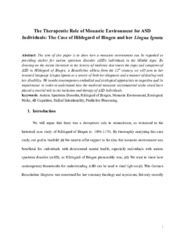Prikaz osnovnih podataka o dokumentu
The Therapeutic Role of Monastic Paideia for ASD Individuals: The Case of Hildegard of Bingen and her Lingua Ignota
| dc.creator | Nešić, Janko | |
| dc.creator | Subotić, Vanja | |
| dc.creator | Nurkić, Petar | |
| dc.date.accessioned | 2024-04-05T09:04:33Z | |
| dc.date.available | 2024-04-05T09:04:33Z | |
| dc.date.issued | 2024 | |
| dc.identifier.issn | 2544-302X | |
| dc.identifier.uri | http://reff.f.bg.ac.rs/handle/123456789/6400 | |
| dc.description.abstract | The aim of this paper is to show how a monastic environment can be regarded as providing shelter for autism spectrum disorder (ASD) individuals in the Middle Ages. By drawing on the recent literature in the history of medicine that traces the signs and symptoms of ASD in Hildegard of Bingen, a Benedictine abbess from the 12th century, we will turn to her invented language Lingua Ignota as a source of both her diagnosis and a manner of dealing with her disability. We invoke contemporary embodied and ecological approaches to cognition and its impairments in order to understand how the medieval monastic sociomaterial niche could have played a crucial role in the inclusion and therapy of ASD individuals. | sr |
| dc.language.iso | en | sr |
| dc.publisher | Faculty of Philosophy, University of Warsaw | sr |
| dc.rights | openAccess | sr |
| dc.rights.uri | https://creativecommons.org/licenses/by-nc-nd/4.0/ | |
| dc.source | Eidos: A Journal for Philosophy of Culture | sr |
| dc.subject | Autism Spectrum Disorder | sr |
| dc.subject | Hildegard of Bingen | sr |
| dc.subject | Monastic Environment | sr |
| dc.subject | Ecological Niche | sr |
| dc.subject | 4E Cognition | sr |
| dc.subject | Skilled Intentionality | sr |
| dc.subject | Predictive Processing | sr |
| dc.title | The Therapeutic Role of Monastic Paideia for ASD Individuals: The Case of Hildegard of Bingen and her Lingua Ignota | sr |
| dc.type | article | sr |
| dc.rights.license | BY-NC-ND | sr |
| dc.citation.issue | 2 | |
| dc.citation.volume | 8 | |
| dc.identifier.fulltext | http://reff.f.bg.ac.rs/bitstream/id/16535/bitstream_16535.pdf | |
| dc.identifier.rcub | https://hdl.handle.net/21.15107/rcub_reff_6400 | |
| dc.type.version | publishedVersion | sr |

